1996 PONTIAC GRAND-AM belt
[x] Cancel search: beltPage 59 of 356
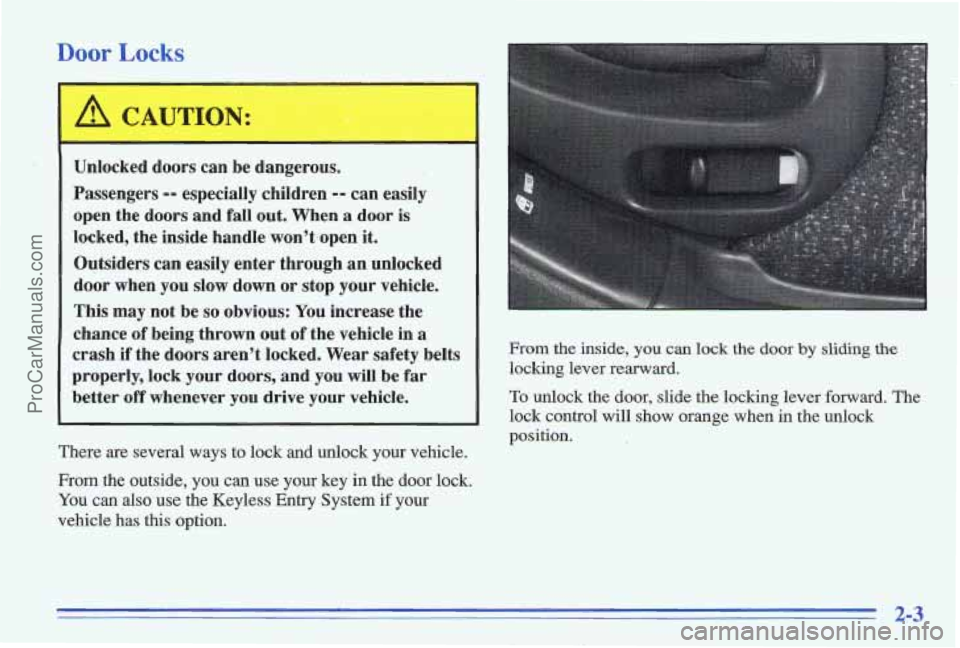
Door Locks
--
,+ I .. .. ,I
Unlocked doors can be dangerous.
Passengers
-9 especially children -9 can easily
open the doors and fall out. When
a door is
locked, the inside handle won’t.open it.
Outsiders can easily enter through an unlocked
door when
you slow down or stop your vehicle.
This
may not be so obvious: You increase the
chance of being thrown out of the vehicle in
a
crash if the doors aren’t locked. Wear safety belts
properly,
lock your doors, and you will be far
better off whenever you drive your vehicle.
There
are several ways to lock and unlock your vehicle.
From the outside, you can use your key in the door lock.
You
can also use the Keyless Entry System if your
vehicle has this option.
From the inside, you can lock the door by sliding the
locking lever rearward.
To unlock the door, slide the locking lever forward.
The
lock control will show orange when in the unlock
position.
2-3
ProCarManuals.com
Page 111 of 356
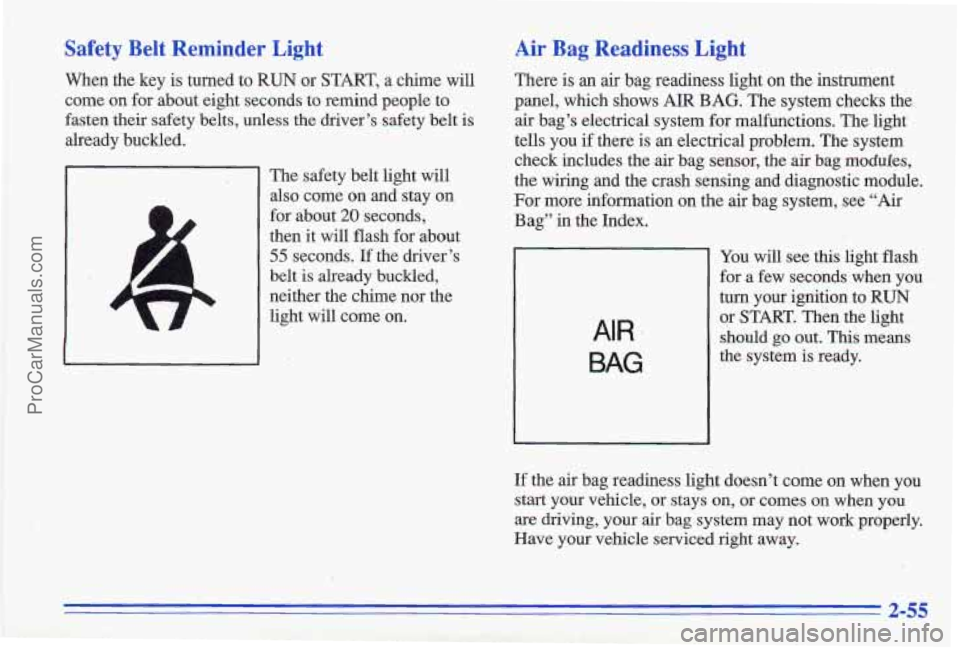
Safety Belt Reminder Light
When the key is turned to RUN or START, a chime will
‘come on for about eight seconds to remind people to
fasten their safety belts, unless the driver’s safety belt i\
s
already buckled.
The safety belt light will
also come
on and stay on
for about
20 seconds,
then it will flash
for about
55 seconds. If the driver’s
belt is already buckled,
neither the chime nor the
light
will come on.
Air Bag Readiness Light
There is an air bag readiness light on the instrument
panel, which shows AIR
BAG. The system checks the
air bag’s electrical system for malfunctions. The light
tells you
if there is an electrical problem. The system
check includes the air bag sensor, the air bag
modules,
the wiring and the crash sensing and diagnostic module.
For more information
on the air bag system, see “Air
Bag” in the Index.
AIR,
BAG
You will see this light flash
for a few seconds when you
turn your ignition to
RUN
or START. Then the light
should
go out. This means
the system
is ready.
If the air bag readiness light doesn’t come
on when you
start your vehicle,
or stays on, or comes on when you
are driving, your air bag system may not work properly.
Have your vehicle serviced right away.
2-55
ProCarManuals.com
Page 112 of 356

Charging System Indicator Light
The charging system
indicator light will come on
briefly when
you turn on the
ignition, but the engine
is
not running, as a check to
show you it is working.
Then it should go out. .. 1.
. I -1
If it stays on when your engine is running, OF comes on
while you are driving, you may have a problem with the
electrical charging system. It could indicate that you
have a loose generator drive belt or another electrical
problem. Have it checked right away. Driving while this
light
is on could drain your battery.
If you mast drive a short distance with the light on, be
certain to turn off all your accessories, such as themdio
and
air conditioner,
Brake System Warning Light
Your Pontiac’s hydraulic brake system is divided into
two parts. If one part isn’t working, the other part can
still w’ork and
stop you. For good braking, though, you
need both
parts workmg well.
If the warning light comes on, there could be a brake
problem. Have your brake system inspected right away.
BRAKE
This light should come ow
briefly when you turn the
ignitibn key
to RUN. If it
doesn’t come on then, have
it fixed so it will be ready to
warn
you if there’s a
problem,
If the light .comes on while you are driving, pull off the
road and stop carefully. You may notice that the pedal is
harder to push. Or, the pedal may go closer to the floor,
It may take longer to stop. If the light is still on, have the
vehicle towed €or
service, (See “Towing Your Vehicle”
in the Index.)
2-56
ProCarManuals.com
Page 147 of 356
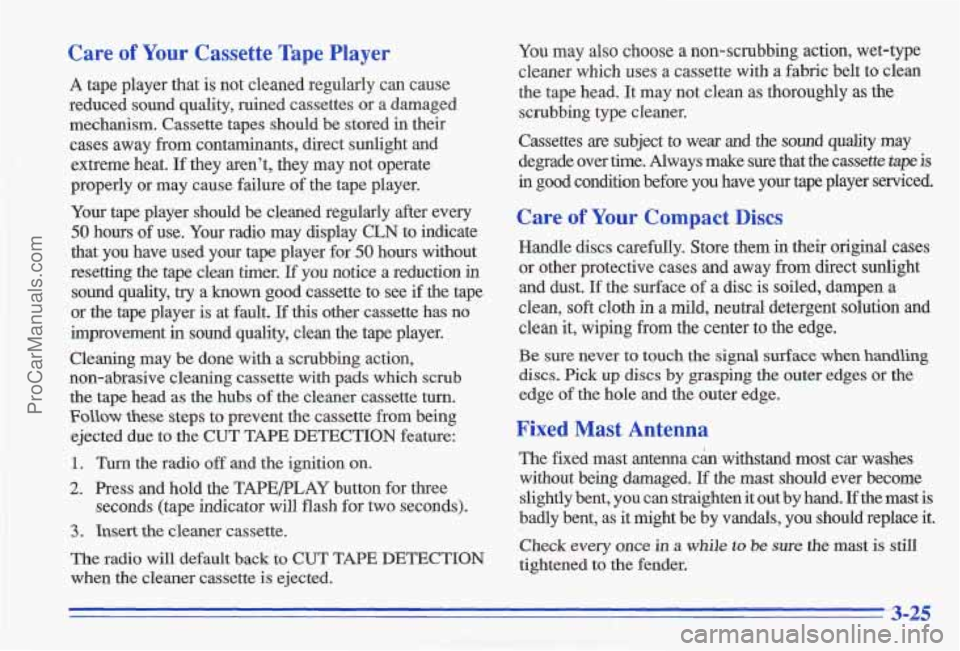
Care of Your Cassette Tape Player
A tape player that is not cleaned regularly can cause
reduced sound quality, ruined cassettes or a damaged
mechanism. Cassette tapes should be stored in their
cases away from contaminants, direct sunlight and
extreme heat.
If they aren’t, they may not operate
properly or may cause failure
of the tape player.
Your tape player should be cleaned regularly after every
50 hours of use. Your radio may display CLN to indicate
that you have used your tape player for
50 hours without
resetting the tape clean timer. If you notice a reduction in sound quality,
try a known good cassette to see if the tape
or the tape player is at fault. If this other cassette has no
improvement
in sound quality, clean the tape player.
Cleaning may
be done with a scrubbing action,
non-abrasive cleaning cassette with pads which scrub
the tape head
as the hubs of the cleaner cassette turn.
Follow these steps to prevent the cassette from being
ejected due to the CUT TAPE DETECTION feature:
1. Turn the radio off and the ignition on.
2. Press and hold the TAPEPLAY button for three
3. Insert the cleaner cassette.
The radio will default back
to CUT TAPE DETECTION
when the cleaner cassette is ejected.
seconds (tape indicator will flash
for two seconds).
You may also choose a non-scrubbing action, wet-type
cleaner which uses a cassette with a fabric belt to clean
the tape head.
It may not clean as thoroughly as the
scrubbing type cleaner.
Cassettes
are subject to wear and the sound quality may
degrade over time. Always make sure that the cassette
tape is
in good condition before you have your tape player serviced.
Care of Your Compact Discs
Handle discs carefully. Store them in their original cases
or other protective cases and away from direct sunlight
and dust.
If the surface of a disc is soiled, dampen a
clean, soft cloth in a mild, neutral detergent solution and
clean it, wiping from the center to the edge.
Be sure never to touch
the signal surface when handling
discs.
Pick up discs by grasping the outer edges or the
edge of the hole and the outer edge.
Fixed Mast Antenna
The fixed mast antenna cb withstand most car washes
without being damaged.
If the mast should ever become
slightly bent, you can straighten it out by hand.
If the mast is
badly bent, as it might be by vandals, you should replace it.
Check every once
in a while to be sure the mast is still
tightened to the fender.
3-25
ProCarManuals.com
Page 149 of 356
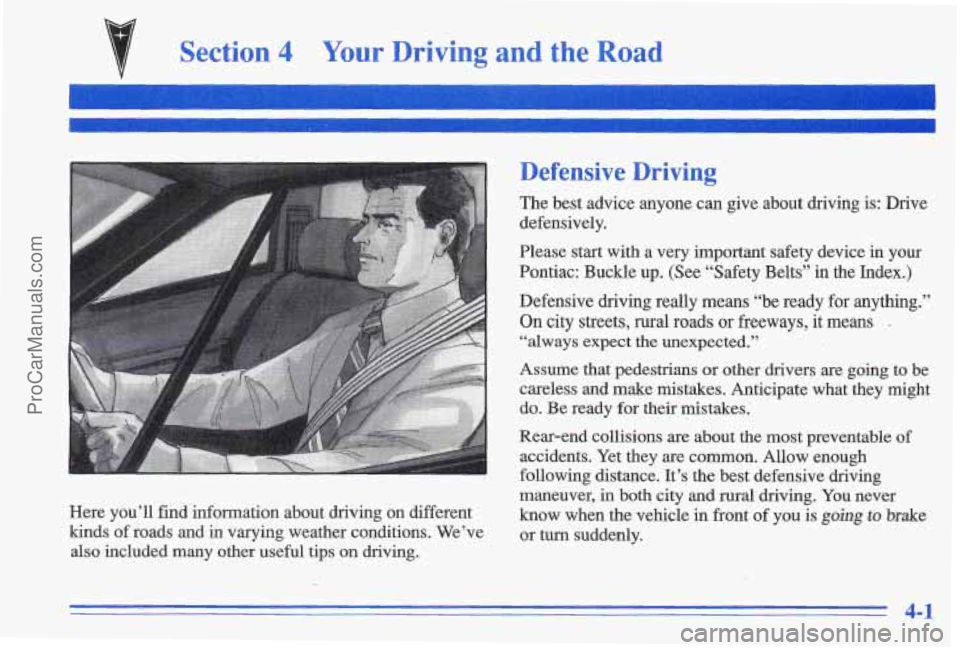
Section 4 Your Driving and the Road
Here you’ll find information about driving on different
kinds of roads and in varying weather conditions. We’ve
also included many other useful tips on driving.
Defensive Driving
The best advice anyone can give about driving is: Drive
defensively.
Please start with a very important safety device in your
Pontiac: Buckle up. (See “Safety Belts” in the Index.)
Defensive driving really means “be ready for anything.”
On city streets, rural roads or freeways, it means .
“always expect the unexpected.”
Assume that pedestrians
or other drivers are going to be
careless and make mistakes. Anticipate what they might do. Be ready for their mistakes;
Rear-end collisions are about ‘the most preventable
of
accidents. Yet they are common. Allow enough
following distance. It’s the best defensive driving
maneuver, in both city and sural driving. You never
know when the vehicle
in front of you is going to brake
or turn suddenly.
4-1
ProCarManuals.com
Page 160 of 356
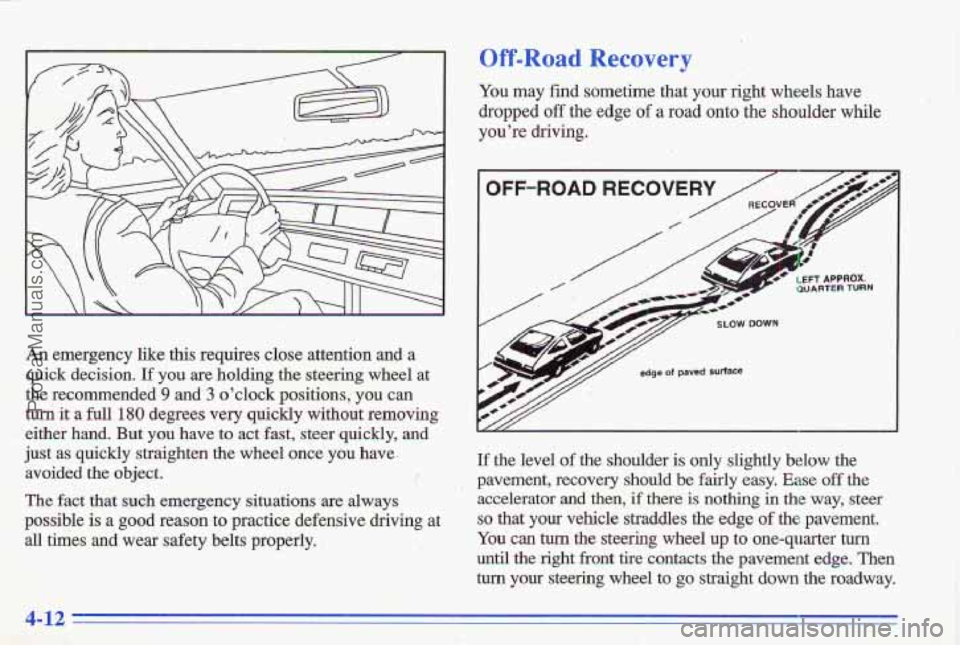
An emergency like this requires close attention and a
quick decision.
If you are holding the steering wheel at
the recommended 9 and' 3 o'clock positions, you can
turn it a full 180 degrees very quickly without removing
either hand. But you have to act ,fast, steer quickly, and
just as quickly straighten the wheel once
you have.
avoided the object.
,(
The fact that such emergency situations are always
possible is a good reason to practice defensive driving at
all times and wear safety belts properly.
..._ - '
Off-Road Recovwy ,. t
', %
You may find sometime that your right wheels have
dropped
off the edge of a road onto the shoulder while
you're
driving.
OFF-RUAD RECOVERY
/- / ,zl I I
-/// edge of paved surface
I
If the level of the shoulder is only slightly below the
pavement, recovery should
be fairly easy. Ease off the
accelerator
and then, if there is nothing in the way, steer
so that your vehicle straddles the edge of the pavement.
You can turn the steering wheel up to one-quarter turn
until the right front tire contacts the pavement edge. Then
turn your steering wheel to go straight down the roadway.
4-12
ProCarManuals.com
Page 188 of 356
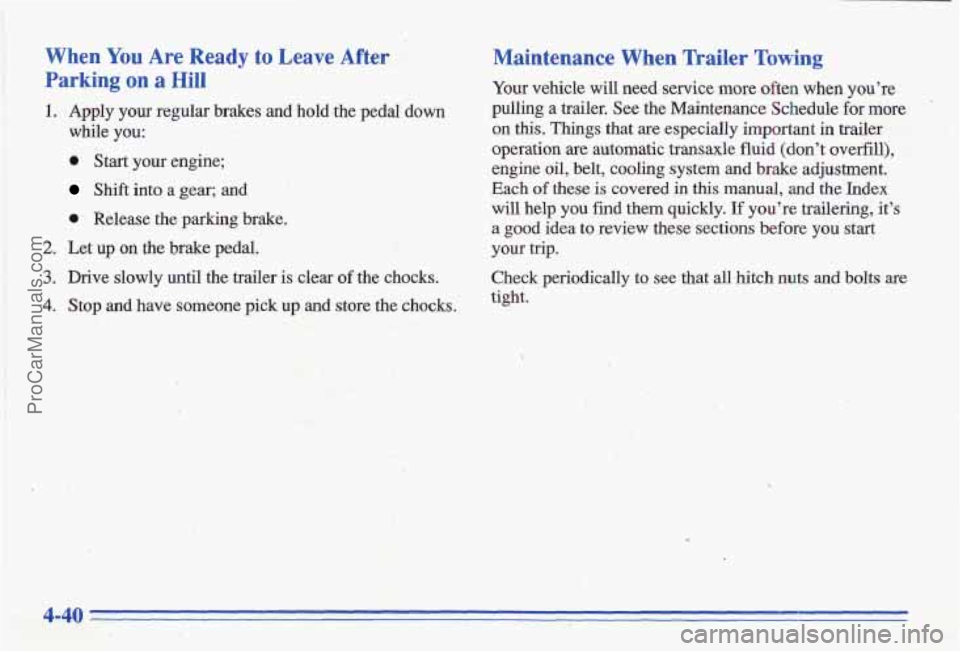
When You Are Ready to Leave After
Parking on a Hill
1. Apply your regular brakes and hold,the pedal down
while
you:
0 Start your engine;
Shift into a gear; and
I. Release the parking brake.
2. Let up on the brake pedal..
3. Drive slowly until the trailer is clear of the chocks.
4. Stop and have someone pick up and store the chocks.
Maintenance When Trailer Towing
Your vehicle will need service more often when you're
pulling a trailer. See the Maintenance Schedule for more
on this. Things that are especially important in trailer
operation are automatic transaxle
fluid (don't ovel-fill),
engine oil, belt, cooling system and brake adjustment.
Each of these is covered in this manual, and the Index
will
help you find them quickly. If you're trailering, it's
a good idea to review these sections before you start
<* ~ I ,,; ;-':'. .a t , ,--: .. ;::l.$.:$ 5
Check periodically to see that all hitch nuts and bolts are
tight.
your trip. ! . .i . :$ ,,- .,,. . . f ~
_I.,
4-40
ProCarManuals.com
Page 262 of 356
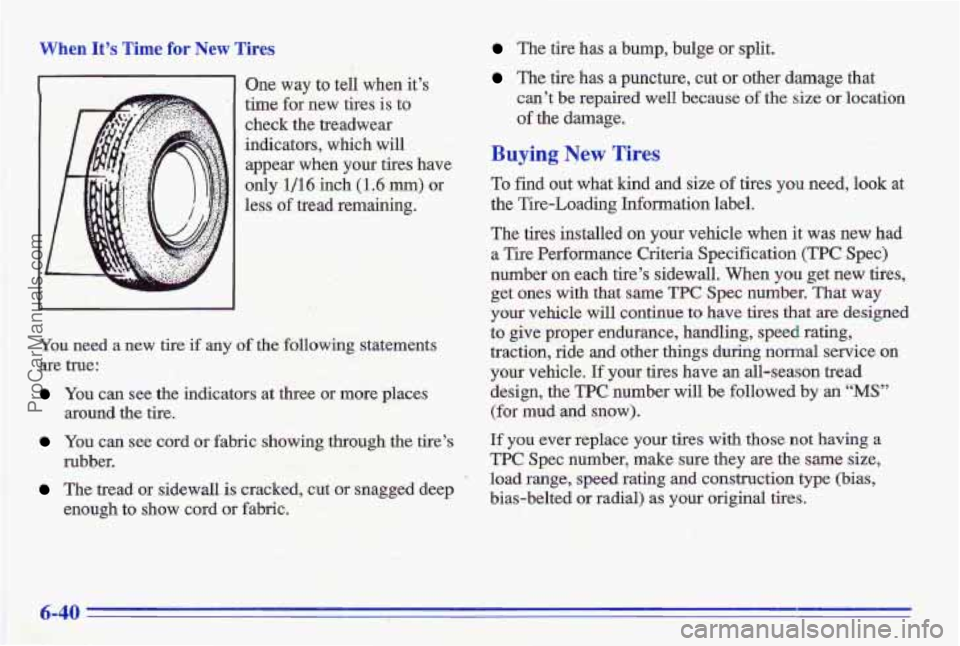
When It’s Time for New Tires
I One wav to tell when it’s
time
fcinew tiies is to
check the treadwear
indicators, which will
,.
appear when your tires have
only 1/16 inch (1.6 rrim) or
less
of tread remaining.
I
You need a new tire if any of the following statements
are true:
, 1, .” ! , .
You cdsee the indicators at three or more places
.. .. . . (. , ;.--.-$ _. . .I :: , L. -. , &&&
-. .. . .I , .I 1 -
around the tire.
You can see cord or fabric showing through the tire’s
The tread or sidewall is cracked, cut or snagged deep
rubber.
enough to
show cord or fabric.
The tire has a bump, bulge or split.
The tire h’as a puncture, cut or other damage that
can’t be repaired
well because of the size or lo’cation
of the damage.
Buying New Tires
To find out what kind and size of tires you need, look at
the Tire-Loading Information label.
The
tires installed on your vehicle when it was new had
a Tire Performance Criteria Specification (TPC Spec)
number
on each tire’s sidewall. When you get new tires,
get ones with that same
TPC Spec number. That way
your vehicle will continue to have tires that are designed
to give proper endurance, handling, speed rating,
traction, ride
and other thing’s during normal service on
your vehicle. If your tires have an all-season tread
design, the
TPC number will be followed by an “MS”
(for mud and snow).
If you ever replace your tires with those not having a
TPC Spec nuhber, make sure they are the same size,
load
range, speed rating &d construction type (bias,
bias-belted
or radial) as your original tires.
..
6-40
ProCarManuals.com